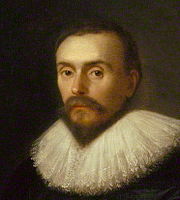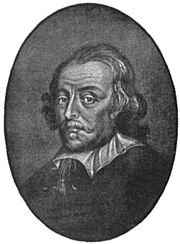
William Harvey
Did you know...
This content from Wikipedia has been selected by SOS Children for suitability in schools around the world. SOS Children is the world's largest charity giving orphaned and abandoned children the chance of family life.
| William Harvey | |
|---|---|
 William Harvey |
|
| Born | April 1, 1578 Folkestone |
| Died | June 3, 1657 |
| Nationality | |
| Fields | physician |
| Doctoral advisor | Hieronymus Fabricius |
| Known for | systemic circulation |
William Harvey ( April 1, 1578 – June 3, 1657) was an English physician who is credited with being the first in the Western world to describe correctly and in exact detail the systemic circulation and properties of blood being pumped around the body by the heart.
Early life and education
Harvey was born in his house (the nearest hospital to Folkestone (in Ashford) is named after him) to a prosperous yeoman, Thomas Harvey, of Folkestone, Kent ( 1578 – 3 June 1657), Turkey Company merchant, and wife Joan Halke, of Hastingleigh Kent ( 1555- 1556 – 8 November 1605), and educated at The King's School, Canterbury. At 16 years of age he was awarded a medical scholarship (founded by Matthew Parker, Archbishop of Canterbury, the first such scholarship in England, for which preference was given to Kentish Men) to Gonville and Caius College, Cambridge, through which he received a Bachelor of Arts degree in 1597. John Caius, who refounded the college before Harvey’s time, used to advise his students to seek some part of their medical education abroad: like him, Harvey went on to the University of Padua (also attended by Copernicus), where he studied under Hieronymus Fabricius, and the Aristotelian philosopher Cesare Cremonini graduating in 1602. He returned to England and married Elizabeth.C.Browne, daughter of Lancelot Browne, a prominent London physician. The couple had no children. He practiced as a physician in London, where he had an appointment at St Bartholomew's Hospital (1609–43) and became a Fellow of the Royal College of Physicians. After his time at St Bartholomew's he returned to Oxford and became Warden (head of house) of Merton College. In 1651 William Harvey donated money to the college for building and furnishing a library, which was dedicated in 1654. In 1656 he gave an endowment to pay a librarian and to present a yearly oration, which continues to happen to the present day in his honour. Harvey also left money in his will for the founding of a boys' school in his native town of Folkestone; opened in 1674, the Harvey Grammar School has had a continuous history to the present day.
Circulation of the blood
Although Ibn al-Nafis and Michael Servetus had described pulmonary circulation before the time of Harvey, all but three copies of Servetus' manuscript Christianismi Restitutio were destroyed and as a result, the secrets of circulation were lost until Harvey rediscovered them nearly a century later. Harvey travelled widely in the course of his researches, especially to Italy, where he stayed at the Venerable English College in Rome.
Hieronymus Fabricius, Harvey's teacher at Padua, had claimed discovery of "valves" in veins, but had not discovered the true use of them. The explanation that he had put forward did not satisfy Harvey, and thus it became Harvey's endeavour to explain the true use of these valves, and eventually, the search suggested to him the larger question of the explanation of the motion of blood. Harvey announced his discovery of the circulatory system in 1616 and in 1628 published his work Exercitatio Anatomica de Motu Cordis et Sanguinis in Animalibus (An Anatomical Exercise on the Motion of the Heart and Blood in Animals), where, based on scientific methodology, he argued for the idea that blood was pumped around the body by the heart before returning to the heart and being re-circulated in a closed system.
This clashed with the accepted model going back to Galen, who identified venous (dark red) and arterial (brighter and thinner) blood, each with distinct and separate functions. Venous blood was thought to originate in the liver and arterial blood in the heart; the blood flowed from those organs to all parts of the body where it was consumed. It was for exactly these reasons that the work of Ibn al-Nafis had been ignored in Europe.
Harvey based most of his conclusions on careful observations recorded during vivisections made of various animals during controlled experiments, being the first person to study biology quantitatively. He did an experiment to see how much blood would pass through the heart each day. In this experiment he used estimates of the capacity of the heart, how much blood is expelled each pump of the heart, and the amount of times the heart beats in a half an hour. All of these estimates were purposefully low, so that people could see the vast amount of blood Galen's theory required the liver to produce. He estimated that the capacity of the heart was 1.5 ounces, and that every time the heart pumps, 1/8 of that blood is expelled. This led to Harvey's estimate that about 1/6 of an ounce of blood went through the heart every time it pumped. The next estimate he used was that the heart beats 1000 times every half an hour, which gave 10 pounds 6 ounces of blood in a half an hour, and when this number was multiplied by 48 half hours in a day he realized that the liver would have to produce 540 pounds of blood in a day. At this time, common thought was that the blood was recycled and not constantly produced.
He proposed that blood flowed through the heart in two separate closed loops. One loop, pulmonary circulation, connected the circulatory system to the lungs. The second loop, systemic circulation, causes blood to flow to the vital organs and body tissue. He also observed that blood in veins would move readily towards the heart, but veins would not allow flow in the opposite direction. This was observed by another simple experiment. Harvey tied a tight ligature onto the upper arm of a person. This would cut off bloodflow from the arteries and the veins. When this was done, the arm below the ligature was cool and pale, while above the ligature it was warm and swollen. The ligature was loosened slightly, which allowed blood from the arteries to come into the arm, since arteries are deeper in the flesh than the veins. When this was done, the opposite effect was seen in the lower arm. It was now warm and swollen. The veins were also more visible, since now they were full of blood. Harvey then noticed little bumps in the veins, which he realized were the valves of the veins, discovered by his teacher, Hieronymus Fabricius. Harvey tried to push blood in the vein down the arm, but to no avail. When he tried to push it up the arm, it moved quite easily. The same effect was seen in other veins of the body, except the veins in the neck. Those veins were different from the others - they did not allow blood to flow up, but only down. This led Harvey to believe that the veins allowed blood to flow to the heart, and the valves maintained the one way flow. Harvey further concluded that the heart acted like a pump that forced blood to move throughout the body instead of the prevailing theory of his day that blood flow was caused by a sucking action of the heart and liver. These important theories of Harvey represent two significant contributions to the understanding of the mechanisms of circulation.
Criticism of Harvey's work
Harveys ideas were eventually accepted during his lifetime. His work was attacked, notably by Jean Riolan in Opuscula anatomica (1649) which forced Harvey to defend himself in Exercitatio anatomica de circulations sanguinis (also 1649) where he argued that Riolan's position was contrary to all observational evidence. Harvey was still regarded as an excellent doctor. He was personal physician to James I (1618-1625). After his and others' attempts to cure James of his fatal illness failed, he became a scapegoat for that failure amidst rumours of a Catholic plot to kill James, but was saved by the personal protection of Charles I (to whom he was also personal physician, from 1625 to 1647). He took advantage of these royal positions by dissecting deer from the royal parks and demonstrating the pumping of the heart on Viscount Montgomery's son, who had fallen from a horse when he was a boy, leaving a gap in his ribs, subsequently covered by a metal plate, which he was able to remove for Harvey. "I immediately saw a vast hole," Harvey wrote, and it was possible to feel and see the heart's beating through the scar tissue at the base of the hole.
His research notes were destroyed in riots in London at start of the English Civil War. He himself went with the king on campaign, and was in charge of the royal children's safety at the Battle of Edgehill, hiding them in a hedge with them reading a book, then forced by enemy fire to shelter behind the Royalist lines, and at the end of the battle tending to the dying and wounded.
Harvey also became the lecturer to the Royal College of Physicians (1615-56).
Marcello Malpighi later proved that Harvey's ideas on anatomical structure were correct; Harvey had been unable to distinguish the capillary network and so could only theorize on how the transfer of blood from artery to vein occurred.
Even so, Harvey's work had little effect on general medical practice at the time — blood letting, based on the prevailing Galenic tradition, was a popular practice, and continued to be so even after Harvey's ideas were accepted. Harvey's work did much to encourage others to investigate the questions raised by his research, and to revive the Muslim tradition of scientific medicine expressed by Nafis, Ibn Sina Rhazes. (See also: François Bernier)
Later years and afterwards
Harvey was a physician and a remarkable natural Historian. Harvey died of a stroke in 1657 at the age of seventy-nine. He was buried in St Andrews Church, Hempsted, England.
Pulitzer Prize-winning historian Arthur Schlesinger Jr. included William Harvey in a list of "The Ten Most Influential People of the Second Millennium" in the World Almanac & Book of Facts.1


